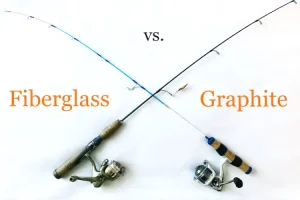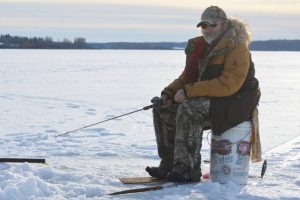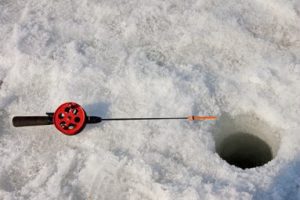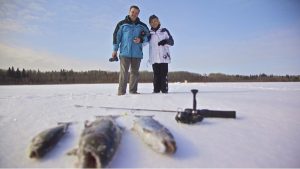Do you use an ice-fishing rod in the summer? When traveling by boat and enjoying fishing, it will be a great time for us for using rods ice fishing as a gear to catch fish. In summer, creating a hole in the ice zone and using ice fishing gear to fish is possible, but it’s not recommended. The reason is that the ice fishing rod is usually made of graphite and will expand and contract with temperature changes.
This can cause the line to break and the rod to bend or break when used in warmer weather. However, there are many aspects that you need to consider when preparing to start fishing in the winter. Let’s see the article below.
Contents
What’s The Difference Between A Regular Rod And An Ice Fishing Rod?
In the winter, you should use a deep-diving ice fishing rod. These rods are designed to go deeper than most ice fishing rods and can get down to the bottom of the lake or river. They’re made of aluminum and have a heavy-duty tip that won’t bend easily.

The biggest difference between the two is that regular fishing rods are designed for shallow-water fishing, so they don’t need to be super strong or sturdy. You’ll want to ensure that your ice fishing pole has some support at the base because it will tend to bend over time as you fish with it.
In addition, some materials are susceptible to low/high temperatures, so the manufacturer will also choose the right material for deployment. It would be the best choice for fishing rods specially made for each season.
See more: Best Striper Fishing Rods For Anglers
Can I Use An Ice Fishing Rod?
Now you know that you can use an ice fishing rod in the summer. However, it is important to understand that your ice fishing equipment will be less effective in the summer than in winter.

If you want to use your ice fishing rod in the summer, you’ll need to modify it so it will last longer:
- Cut off all the handles on either side of your ice fishing rods (this makes it easier for you to hold onto).
- Coat both sides of your ice fishing rods in clear nail polish so they don’t get too hot when exposed to summer heat.
- Wrap your ice fishing line around something like a rope or tree branch so that it does not unravel while used in warm weather.
However, consider purchasing a new ice fishing reel and line if you plan to ice fish during warm weather.
See more Leaving fishing rods unattended
Will Heat Damage Fishing Rods?
The short answer is yes; heat can damage your fishing rod. Most ice fishing rods are made of graphite, which is durable, and resistant to high temperatures. But if you use a rod not made of graphite, your ice fishing rod may get hot enough to burn out the tip of the line.

If this happens, your line will break, and you’ll lose all your fish. This happens in the middle of a tournament or tournament day; then, there’s nothing worse than losing all of your fish!
The best way to avoid damage from high temperatures is to use an aluminum rod with a cork handle or graphite handle. Both materials are very durable and resistant to high temperatures.
Why Are Ice Fishing Rods So Small?
The rods are small because they are designed to be portable and easy to use. The smaller the rod, the easier it is to carry around and use on the water. Also, ice fishing rods are designed for comfort when you’re out on the ice catching fish. Besides, these are designed for one-handed usage. This means that you can easily hold it with just one hand and reel in your catch with the other.
However, the size of an ice fishing rod depends on where you plan on catching your fish. A standard-size fishing rod would be fine if you’re going out into the lake or river with a line and a hook.
How Do I Choose An Ice Fishing Rod?
The first thing you need to consider when using an ice fishing rod is how much space it will take up in your car or truck. You want to ensure that whatever use size fit-rod into a locker at some point during the day so that you can get back and forth between work and home without having to worry about taking other items along with you (like a cooler or food).

The single rod’s length is a crucial consideration. We cannot select a 2.7m rod when the reach is 4.5m, 5.5m, or 7.2m… Alternatively, if the water is up to 4 meters high, we cannot select a single 3.6-meter-long rod. Anglers should choose the length of the single rod to fit the fishing grounds and water depth. The length can vary depending on the sentence type, but it is typically 3.6 meters.
Additionally, as stiffness impacts numerous variables when employing a single rod, it is essential to pay attention to it. The size and length of the fishing line influence this element. The rods with low stiffness, typically ranging from 2H to 4H, are categorized as soft rods if we combine them with tiny wire sizes. The wire stiffness will be between 5H and 7H when wiring a big shaft with a 3.0 pitch.


